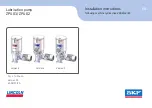
Operating Instructions
Insulated Conductor Rail System
SinglePowerLine Program 0813
BAL0813-0007-EN
www.conductix.com
translated document
page 61 of 108
Fig. 80: Slide the insulating cap halves onto the conductor rail ends
→
Cut a rubber sleeve (Pos. 3) according to the cable diameter and slide the stripped ends of the connecting cable (Pos. 2) through
the sleeves (one-sided or two-sided connection possible).
For better sealing, Conductix-Wampfler recommends pulling a shrink tube over the cable beforehand
and connecting it to the sleeve with a hot air blower after installation.
Fig. 81: Slide the cable ends through the sleeves
→
To ensure a good current transfer over the long term, the conductor rail ends must be cleaned and thinly coated with contact
grease.
→
Mount the connector (Pos. 4) with tubular cable lug (Pos. 5) as described in Section 6.4.3.4 (see Fig. 75). Observe the tightening
torque of 31 Nm. In the case of copper rails, check via the inspection window whether the ends of the conductor rails are 2 to
3 mm apart (see Fig. 73). With the other conductor bars, it must be ensured that the ends of the conductor rail are in contact
with the stopper in the connection plate (see Fig. 72).
1
















































